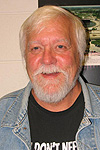Bob Slazyk retires after 34 years at Fermilab
 |
|
Bob Slazyk
|
Accelerator Division Technical Supervisor Bob Slazyk came to Fermilab in 1981. Now, 34 years later, he is retiring. Before coming to Fermilab, Bob served for four years in the Marine Corps as an aircraft machinist. He rose to the rank of sergeant as he served time in east Asia. He credits learning his leadership skills during this time. Bob began at Fermilab working in the Magnet Factory. Within a few years, he became the supervisor of the Low-Conductivity Water Group (now the Fluids Group) for the Accelerator Division. Through the years, Bob has helped build and maintain every fluids system within the accelerator complex, including the Tevatron, Main Injector, Booster, Linac and the external beam systems.
"Bob has a special ability and a presence toward solving problems and coming up with 'off the cuff' solutions out in the field," said Maurice Ball, Bob's director supervisor and a Mechanical Support Department engineer. "Given the critical nature of process fluid systems in accelerator operations, Bob made a lasting impact, and he will surely be missed."
The most memorable work for Bob was building the Main Injector low-conductivity water system, one of the most extensive systems he worked on. When the piping was completed, the system passed the usual leak check. However, several weeks later, upon startup of the pumps, several puzzling, pinhole leaks appeared near the new welds. Outside microbiologic and piping experts revealed that the cause of the leaks were microorganisms residing on the welded areas. The resulting colonies of bacteria created corrosion cells that quickly ate away at the susceptible weld metal. The entire system was drained, cleaned, rewelded and then filled with UV-treated, filtered water.
The nearly year-long treatment was effective: The system has been leak-tight and operational for more than 15 years.
To lead the building of the water system and to troubleshoot the source of this unusual problem, Bob had to not only understand process piping, but also become familiar with microorganisms. Certainly, this was a field that he never thought he had to learn about when he came to Fermilab.
"Working at Fermilab has been fascinating! I have learned so much science through years," Bob said, reflecting on his time at the lab. "I never thought I would stay in one place for so long."
A retirement lunch is scheduled for Thursday, Oct. 22, at the Riverview Banquets in Batavia. To sign up for the event, please contact Ruth Becker at x4736 or rbecker@fnal.gov by Monday, Oct. 19. Bob's retirement date is Nov. 11.
—Mayling Wong-Squires and Patrick Hurh, AD
|